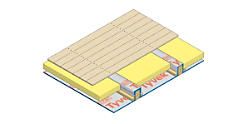Airtight Suspended Timber Floors
Moisture Management for Suspended Timber Floor Construction
Many suspended timber floor constructions have discontinuous insulation between the joists. That leaves an opening to improve moisture management and airtightness – by fitting a Tyvek® membrane and carefully sealing the gaps and joints.

Tyvek® membranes are ideal for suspended timber floor construction. They are vapour-open, yet greatly reduce air flow when correctly installed. This helps to minimise underfloor condensation (and hence the risk of mould or decay) while improving the thermal efficiency of your floor and building.
Achieving Airtightness
Tyvek® Supro membranes are sturdy and durable. They provide adequate support for the insulation, and are recommended for use in suspended timber floor constructions. To achieve optimal airtightness in suspended timber floor construction, however, it is important to fit them methodically. Airtightness can only be achieved if the membrane is laid continuously with sealed laps.
Full Range of Accessories
DuPont has a full range of top quality tapes and accessories to help you achieve optimal airtightness. Click here for details:
Tyvek® Breather Membrane Solutions
Breather membranes play a key role in protecting buildings and occupants from the elements. Investing in a quality solution like DuPont™ Tyvek® can help provide long-term building protection – and peace of mind too.
Tyvek® & AirGuard® Sealing Tapes
Tyvek® and AirGuard® sealing tapes and accessories are specifically designed to complement Tyvek® breather membranes and AirGuard® air and vapour control membranes. They help to seal the building envelope, offering optimal airtightness, energy efficiency, long-term performance and durability.
AirGuard®: Vapour Control Layer Solutions
An AirGuard® vapour control layer can significantly reduce heat loss and increase energy efficiency. By controlling heat transfer and reflecting heat inside the building, they help keep buildings cool in summer, and warm in winter.
